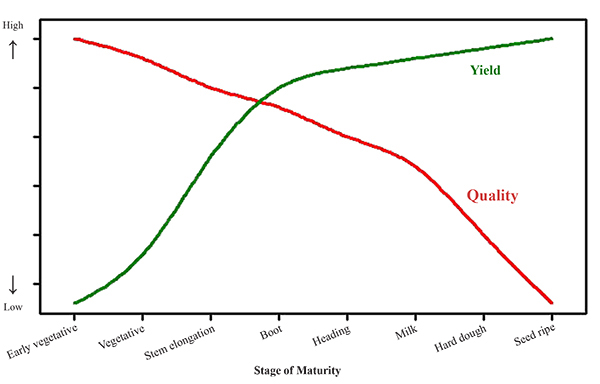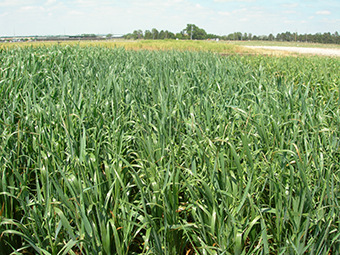G2185
Utilizing Annual Forages with Limited Irrigation for Beef Cattle During and Following Drought
Recommendations for planting annual forages as alternatives to rangeland and pasture damaged by drought and excessive grazing.
Aaron L. Berger, Extension Educator
Tom L. Holman, Extension Educator
Jerry D. Volesky, Extension Range and Forage Specialist
Karla H. Jenkins, Cow-calf, Range Management Extension Specialist
- Replacement Feed and Forage Alternatives Utilizing Limited Irrigation
- Management Options to Capture Maximum Amount of Energy from Annual Forages
|
Precipitation can be below average for much of western Nebraska for prolonged periods. Rangeland and pasture vegetation in semi-arid environments, like central and western Nebraska, can be easily damaged by drought stress and/or excessive grazing. Consequently, even if soil moisture is not limited in the years following a drought, spring growth rate will be reduced and total annual forage production can be 20 to 50 percent below average. Therefore, stocking rates should be reduced 20 to 50 percent.
Growth of belowground plant parts in grasses is proportional to the amount of top growth each year. Drought-limited plant growth and/or excessive livestock grazing will reduce root growth, levels of stored energy, and formation of buds needed for future-year tillers. In addition, the remaining plant cover will be insufficient to keep rainwater from evaporating or running off the soil surface. The effects of drought will make it extremely difficult for most rangelands in the region to produce average levels of forage in the year following the drought even with above-average precipitation. Therefore, use of pastures in Nebraska should be delayed until June 1 for predominately cool season pastures or June 15 on rangeland predominated by warm season species. The greatest number of cow-days per acre will be obtained when pastures are not grazed until plants have completed most of their growth for the year. Using confinement feeding (see NebGuide G2099, Crop Residues or Low Quality Hay Combined with Byproducts as a Forage Substitute) and/or planted forages can provide alternatives so cattle can be kept off pastures and rangeland during the spring and well into the summer to allow unimpeded plant growth.
Continuation of drought, especially below average precipitation during April, May, and June, will eliminate opportunities for safe summer grazing on all pastures with limited plant cover.
Producers should consider limited irrigation and dryland forage crops as alternatives to pasture and rangeland requiring rest or deferred grazing.
Replacement Feed and Forage Alternatives Utilizing Limited Irrigation
Forage Production With Limited Irrigation Water (3-6 inches)
Plant spring small grains (oats, spring triticale, barley) March 15 to April 30.
- Seeding rate:
- Oats: 60-80 lb/acre
- Spring triticale, barley: 90-120 lb/acre
- Forage peas (plant according to label directions)
- Fertilize according to soil test recommendations.
- Production: 2,000-3,000 pounds dry matter/acre.
- Graze out 50 to 55 days after planting (begin grazing when plants have achieved 6 inches growth).
- Hay mid to late June.
Plant winter wheat, rye, or triticale Feb. 15 to March 15 (Also see NebGuide G2012, Forage Production with Limited Irrigation).
- Seeding rate: 100-120 lb/acre.
- Fertilize according to soil test recommendations.
- Production: 2,000 pounds dry matter/acre.
- Graze 40 to 50 days after planting (6 inches of growth).
- Do not expect grain yield.
Plant warm season annuals (pearl millet, sorghum-sudan hybrids, sudangrass) from May 15 through July (see NebGuide G2172, Summer Annual Forages for Beef Cattle in Western Nebraska).
- Seeding rate: Contact seed supplier for recommended seeding rates for the specific variety and species being planted.
- Fertilize according to soil test recommendations.
- Production: 4,000-6,000 pounds dry matter/acre.
Plant cool season annuals (oats, spring triticale, barley, spring wheat, turnips, and other brassicas) from July 15 through August.
- Seeding rate: Contact seed supplier for recommended seeding rates for the specific variety and species being planted. Typical rates are:
- Oats: 80-100 lb/acre
- Spring triticale, spring wheat, barley: 90-120 lb/acre
- Turnips and Brassicas: 1-5 lb/acre
- Fertilize according to soil test recommendations.
- Production: 1,500-3,000 pounds dry matter/acre (later planting dates result in lower yield).
- Graze out 50 to 60 days after planting (8 or more inches of growth)
- Forage can be swathed in mid to late October to help preserve quality into the winter and windrows directly grazed (see NebGuide G1616, Windrow Grazing).
Average Irrigation Water Available (6-12 inches)
Plant spring cereal grains, spring triticale, oats, barley, and peas March 15 to April 30.
- Seeding rate:
- Spring triticale, barley 100-120 lb/acre
- Oats 70-100 lb/acre
- Peas (plant according to label directions)
- Fertilize according to soil test recommendations.
- Production: 3,000-6,000 pounds dry matter/acre.
- Graze 45 to 55 days after planting (6 inches of growth).
- Hay mid to late June.
Plant winter wheat, rye, or triticale Feb. 15 to March 15.
- Seeding rate: 100-120 lb/acre.
- Fertilize according to soil test recommendations.
- Production: 3,000 pounds dry matter/acre.
- Graze 40 to 50 days after planting (6 inches of growth).
Plant warm season annuals (pearl millet, foxtail millet, sorghum-sudan hybrids, sudangrass, corn) from June 1 to Aug. 1.
- Seeding rate: Contact seed supplier for recommended seeding rates for the specific variety and species being planted.
- Corn 40 lb/acre.
- Fertilize according to soil test recommendations.
- Production: 5,000-7,000 pounds dry matter/acre.
Plant cool season annuals (oats, spring triticale, barley, spring wheat, turnips, and other brassicas) from July 15 through Aug. 31.
- Seeding rate: Contact seed supplier for recommended seeding rates for the specific variety and species being planted.
- Fertilize according to soil test recommendations.
- Production: 2,000-5,000 pounds dry matter/acre.
- Seeding rate:
- Oats: 80-100 lb/acre
- Spring triticale, spring wheat, barley: 90-120 lb/acre
- Turnips and Brassicas: 1-5 lb/acre
- Fertilize according to soil test recommendations.
- Graze out 50 to 60 days after planting (8 or more inches of growth).
- Forage can be swathed in mid to late October to help preserve quality into the winter and windrows directly graze (see NebGuide G1616, Windrow Grazing).
Management Options to Capture Maximum Amount of Energy from Annual Forages
During drought conditions, producers will want to efficiently utilize available annual forage with cattle. The maximum amount of useable energy per acre from annual forages will be obtained when producers allow forage to reach the boot to soft dough stage of maturity before harvesting (Figure 1). The optimum point for harvesting varies with the annual forage used. Consider the following guidelines:
- Cereal rye — boot
- Spring triticale or spring wheat — boot to early head
- Oats — head to soft dough
- Sorhgum-sudan hybrids, foxtail millet, or sudangrass — early head
Obviously this window of opportunity for harvest is too narrow for the standing forage to effectively be utilized by direct grazing. Grazing crops at this stage of maturity would result in significant forage being wasted. However, swathing the crop at the optimum stage of maturity and then strip grazing using a temporary electric fence or an electric fence attached to a center pivot, which is moved periodically to limit access to windrows, can result in harvest efficiency of 85 percent or greater. For more information on management and use of this technique for forage harvesting, please see NebGuide G1616, Windrow Grazing.
 |
| Figure 1. Generalized relationship between forage and forage quality as affected by stage of maturity. |
Producers may find that direct, rotational grazing of annual forages at vegetative stages and then utilizing windrow grazing as forages mature will improve overall forage yield and utilization efficiency. Planting a sequence of forages that mature at different times (spring triticale, oats, sudangrass) is another way producers can have forage available for direct or windrow grazing throughout the spring and summer. Planning, along with efficient utilization can help maximize the amount of forage consumed from annual forage plantings.
When grazing lush immature small grain forages, be sure to provide cattle with high magnesium and calcium supplements starting a couple of months before turnout. This will help reduce changes of grass tetany. Cattle need to consume 3 to 4 ounces per day of a mineral containing 12 to 15 percent magnesium.
Nitrate and prussic acid poisoning are not generally a concern unless plants are stressed by drought or frost. Nitrates tend to be lower in forages harvested close to maturity, and raised with adequate moisture. Prussic acid poisoning can be avoided if stressed plants are not grazed for approximately seven days after a frost. For more information on managing nitrates in cattle feed see NebGuide G1779, Nitrates in Cattle Feeding.
This publication has been peer reviewed.
Visit the University of Nebraska–Lincoln Extension Publications website for more publications.
Index: Range & Forage
Forages
Issued February 2013
